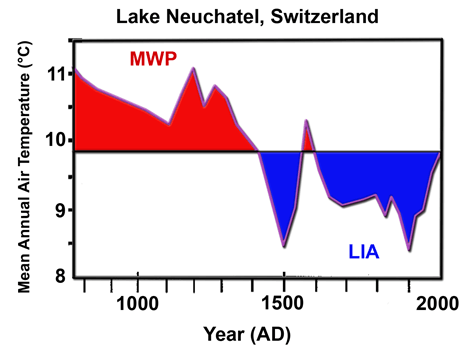Reference
Filippi, M.L., Lambert, P., Hunziker, J., Kubler, B. and Bernasconi, S. 1999. Climatic and anthropogenic influence on the stable isotope record from bulk carbonates and ostracodes in Lake Neuchatel, Switzerland, during the last two millennia. Journal of Paleolimnology 21: 19-34.
Description
The authors obtained stable isotope data (δ18O and δ13C) from bulk carbonate and ostracode calcite in a radiocarbon-dated sediment core retrieved from Lake Neuchatel (about 46.8°N, 6.7°E) in the western Swiss Lowlands at the foot of the Jura Mountains, which they used to reconstruct the climatic history of the region over the past 1500 years. Their data suggest that mean annual air temperature dropped by about 1.5°C during the transition from the Medieval Warm Period (MWP) to the Little Ice Age (LIA); and they state that "the warming during the 20th century does not seem to have fully compensated [for] the cooling at the MWP-LIA transition," indicating that during the Medieval Warm Period mean annual air temperatures were, in their words, "on average higher than at present." From their Figure 4a (reproduced below) we estimate that peak temperatures during the MWP were about 1.2°C warmer than the peak temperatures of the Current Warm Period.





